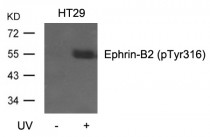ARG51683
anti-Ephrin B2 phospho (Tyr316) antibody
anti-Ephrin B2 phospho (Tyr316) antibody for Western blot and Human,Mouse
Cancer antibody; Cell Biology and Cellular Response antibody; Neuroscience antibody
Overview
| Product Description | Rabbit Polyclonal antibody recognizes Ephrin B2 phospho (Tyr316) |
|---|---|
| Tested Reactivity | Hu, Ms |
| Tested Application | WB |
| Host | Rabbit |
| Clonality | Polyclonal |
| Isotype | IgG |
| Target Name | Ephrin B2 |
| Antigen Species | Human |
| Immunogen | Peptide sequence around phosphorylation site of tyrosine 316 (P-V-Y(p)-I-V) derived from Human Ephrin-B2 |
| Conjugation | Un-conjugated |
| Alternate Names | HTK ligand; HTKL; Htk-L; EPLG5; Ephrin-B2; HTK-L; LERK5; LERK-5; EPH-related receptor tyrosine kinase ligand 5 |
Application Instructions
| Application Suggestion |
|
||||
|---|---|---|---|---|---|
| Application Note | * The dilutions indicate recommended starting dilutions and the optimal dilutions or concentrations should be determined by the scientist. |
Properties
| Form | Liquid |
|---|---|
| Purification | Antibodies were produced by immunizing rabbits with KLH-conjugated synthetic peptide. Antibodies were purified by affinity-chromatography using epitope-specific peptide. |
| Buffer | PBS (without Mg2+ and Ca2+, pH 7.4), 150mM NaCl, 0.02% Sodium azide and 50% Glycerol. |
| Preservative | 0.02% Sodium azide |
| Stabilizer | 50% Glycerol |
| Concentration | 1 mg/ml |
| Storage Instruction | For continuous use, store undiluted antibody at 2-8°C for up to a week. For long-term storage, aliquot and store at -20°C. Storage in frost free freezers is not recommended. Avoid repeated freeze/thaw cycles. Suggest spin the vial prior to opening. The antibody solution should be gently mixed before use. |
| Note | For laboratory research only, not for drug, diagnostic or other use. |
Bioinformation
| Database Links | |
|---|---|
| Gene Symbol | EFNB2 |
| Gene Full Name | ephrin-B2 |
| Background | This gene product belongs to the 14-3-3 family of proteins which mediate signal transduction by binding to phosphoserine-containing proteins. This highly conserved protein family is found in both plants and mammals, and this protein is 99% identical to the mouse, rat and sheep orthologs. The encoded protein interacts with IRS1 protein, suggesting a role in regulating insulin sensitivity. Several transcript variants that differ in the 5' UTR but that encode the same protein have been identified for this gene. |
| Function | Cell surface transmembrane ligand for Eph receptors, a family of receptor tyrosine kinases which are crucial for migration, repulsion and adhesion during neuronal, vascular and epithelial development. Binds promiscuously Eph receptors residing on adjacent cells, leading to contact-dependent bidirectional signaling into neighboring cells. The signaling pathway downstream of the receptor is referred to as forward signaling while the signaling pathway downstream of the ephrin ligand is referred to as reverse signaling. Binds to receptor tyrosine kinase including EPHA4, EPHA3 and EPHB4. Together with EPHB4 plays a central role in heart morphogenesis and angiogenesis through regulation of cell adhesion and cell migration. EPHB4-mediated forward signaling controls cellular repulsion and segregation from EFNB2-expressing cells. May play a role in constraining the orientation of longitudinally projecting axons. [UniProt] |
| Research Area | Cancer antibody; Cell Biology and Cellular Response antibody; Neuroscience antibody |
| Calculated MW | 37 kDa |
| PTM | Inducible phosphorylation of tyrosine residues in the cytoplasmic domain. |
Images (1) Click the Picture to Zoom In






